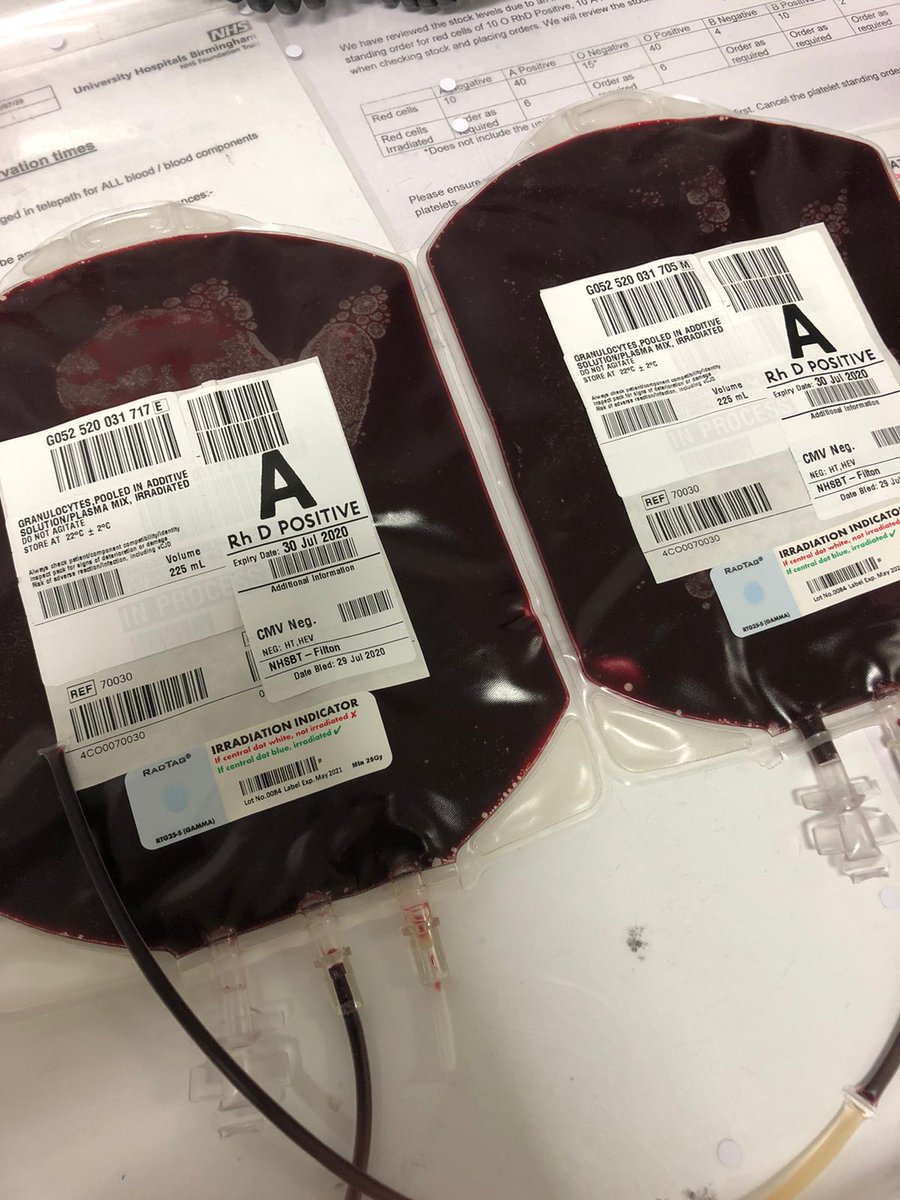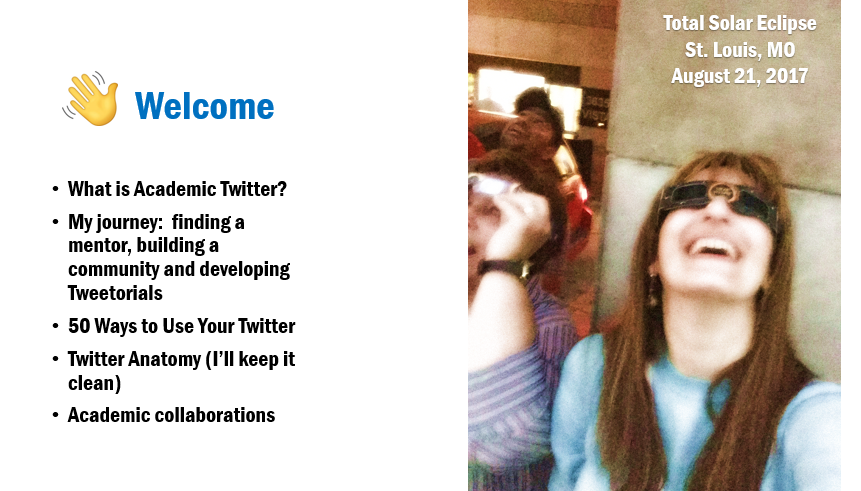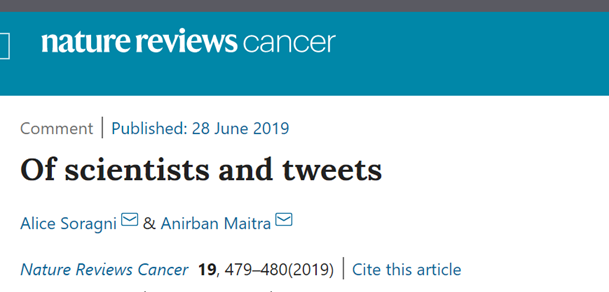Discover and read the best of Twitter Threads about #Blooducation
Most recents (24)
I had a personal request to do a tweetorial for the #haemSpRs on haemovigilance. Here goes. A #blooducation 🧵
Haemovigilance is a systematic surveillance of adverse reactions and adverse events related to transfusion’ with the aim of improving transfusion safety.
transfusionguidelines.org/transfusion-ha…
transfusionguidelines.org/transfusion-ha…
We are very lucky in the UK to have @SHOTHV1, one of the first in the world to collate adverse events relating to transfusion - since the 1990s.
This morning I met with the chair and vice chair of the Midlands Regional Transfusion Committee, the Midlands Patient Blood Management Practitioner and the Customer Services Manager. What are their roles and what does the RTC do?
A #blooducation 🧵
A #blooducation 🧵
RTCs serve to bring together Hospital Transfusion Committees to discuss best practice, implement new guidance and provide educational resources and events. They are run by clinicians and scientists working in hospitals, supported by @NHSBT.
There are 7 RTCs in England transfusionguidelines.org/uk-transfusion… (NB map hasn’t been updated to reflect recent changes) @london_rtc @NEY_RTC @SW_RTC @SEC_RTC
Teaching our incoming haematology doctors today about transfusion in haematology patients. So who needs irradiated blood and why? A #blooducation🧵
All blood in the UK is leucocyte reduced (except granulocytes, but that’s another story). Despite this, a unit of red cells or platelets can have around a million residual white cells, mostly lymphocytes.
(for the #haemSpRs, that’s < 5 x 10^6 leucocytes/unit in > 99 % of units and < 1 x 10^6 leucocytes/unit in > 90% of units, both with 95% statistical confidence)
nhsbtdbe.blob.core.windows.net/umbraco-assets…
nhsbtdbe.blob.core.windows.net/umbraco-assets…
Thank you for joining me to today for the @SSMHealthSTL Pediatric Education Webinar Series where we discussed the topic of 🩸👶🏾Pediatric Patient Blood Management.
From our rural hospitals to large academic ones, together let's optimize pediatric & neonatal care.
👇🏽 #Blooducation
From our rural hospitals to large academic ones, together let's optimize pediatric & neonatal care.
👇🏽 #Blooducation

Coming out of #WorldBloodDonorDay, it was perfect timing to discuss this topic as we celebrate our incredible blood donors while bringing awareness of the need to collect and transfuse safe blood to our patients, many which are so 🖐️🏽tiny, fitting within the palm of our hand. 

Bone marrow biopsy (BMB) FAQs! Ever wondered what it's all about? Keep reading... 👀
What makes up a BMB? Usually it includes 2 samples - the aspirate (liquid marrow 🩸) and the trephine (bone core 🦴)
Why do we need 2 samples? The aspirate allows us to individually look at each BM cell under the microscope 🔬 (e.g. WBCs, RBCs) and classify them via flow cytometry (a method of identifying and measuring pathological cells using their surface markers e.g. CD19 for B-cells)
🅰️🅱️🅾️🆎#Blooducation colleagues: Fantastic new @bloodbankguy 🎧podcast with Dr. Mark Yazer on the topic of Whole Blood in Trauma Resuscitation discussing benefits and safety, and review of many important published trials. Listen now --> BBGuy.org/091. 

Dr. Yazer explains some major benefits of #wholeblood. Balanced resuscitation in just 👜ONE bag, making logistics so much easier. There are fewer donor exposures and less additives & anticoagulants. Additionally, cold stored platelets are "primed for coagulation activity" 



In 2018, 31rst @AABB Standards indicates that the definition of “low titer” shall be made locally by each transfusion service, and that policy specifies which patients are eligible to receive whole blood, the maximum quantity of how to monitor for adverse events post transfusion.
A 1 day y/o 👶🏽neonate, born at 40 weeks, was transferred to our NICU for anemia & hyperbilirubinemia. He is jaundice but has no signs of encephalopathy.🩸The antibody screen is positive.
👇🏽Check out his peripheral smear below and notice the increased number of nucleated RBCs.
👇🏽Check out his peripheral smear below and notice the increased number of nucleated RBCs.
🤔Based on the peripheral smear findings, you begin to investigate the patient’s blood bank history because you are suspecting:
🙌🏽You got it! Based on the history and the peripheral smear findings, you are suspecting hemolytic disease of the fetus and newborn (#HDFN), which is when maternal antibodies are directed against fetal RBC antigens. What is the most common cause of #HDFN?
#Blooducation
#Blooducation
Listen now! #Blooducation Graphic Medicine @Pathologists virtual lecture with @KreuterMD
learn.cap.org/lms/activity_o…
learn.cap.org/lms/activity_o…

Important to know how to approach a #DonorLookBack which is a multistep process a blood establishment must complete as a response to a donor who is newly reactive for an infectious disease test. Check out @bloodbankguy for more information 👆🏼👉🏼 bbguy.org/education/glos… 

1/ Antidote news! There has been promise recently regarding antidotes being developed for DOACs. Before we get onto that, a quick summary of what we have so far...
2/ In the case of bleeding while on warfarin, this should be stratified by severity. Usual rule is if life/limb/sight threatening bleeding, prothrombin complex concentrate + vit K is used. If not, vitamin K +- pause/cessation of warfarin is advised.
3/ Warfarin works by inhibiting vitamin K-dependent clotting factor production. These factors are II, VII, IX and X. The 'antidote' is prothrombin complex concentrate (e.g beriplex) which is a concentrated 'soup' of factors II, VII, IX and X (and some protein C and S)
I was on call for NHSBT last week and have discussed lots of patients for whom we have agreed to transfuse granulocytes (GTX). But what are they, when do we use them and how can you get hold of them? #blooducation 

I wrote a tweetorial and it was soooo long, so I’ve divided it into chunks (I LOVE granulocytes) 🙈. So, here’s part 1.
We often tell patients we can transfuse red cells and platelets, but not white cells. But that’s not really true! GTX are started in around 2 new patients/week in England (more last week!), and can be given for as long as is needed (more on dosing and timing later)
Recently, blood bank brought to my attention a patient under haematology who was pancytopenic.
Hb 77 g/L
WCC 8.4 x10^9/L
Plt 41 x10^9/L
What is the usual red cell transfusion threshold for patients with haematological malignancy?
#blooducation
Hb 77 g/L
WCC 8.4 x10^9/L
Plt 41 x10^9/L
What is the usual red cell transfusion threshold for patients with haematological malignancy?
#blooducation
In the absence of active bleeding or acute coronary syndrome, NICE recommend a transfusion threshold of 70 g/L. Some haematology units use 80 g/L although this is not supported by UK guidance.
nice.org.uk/guidance/ng24/…
nice.org.uk/guidance/ng24/…
There are a few RCTs in haematology patients but we can discuss those another time!
Patients with chronic transfusion dependent anaemia should be transfused to individualised thresholds depending on symptoms.
Patients with chronic transfusion dependent anaemia should be transfused to individualised thresholds depending on symptoms.
Yesterday I met with our fantastic BMSes and MLAs to go over interesting/tricky cases this week. We talked about indications for washed platelets. #blooducation
Washed platelets are indicated in order to reduce risk of
Washed platelets are indicated in order to reduce risk of
Washed platelets are given to patients with a history of recurrent allergic reactions. Allergy is usually to proteins in the plasma element of the platelet unit, so removing the plasma reduces the risk.
Standard pooled platelets from @NHSBT are now in 65% PAS (additive solution) and 35% (male) plasma. Apheresis platelets are in plasma. Washed platelets are in "100%" PAS.
Today I did an online tutorial with the West Midlands #haemSpRs. It was good to do some teaching after a bit of a hiatus! We've always done online tutorials on Whatsapp but videoconferencing was a win. #Covidsilverlinings
Follow this thread for a #blooducation #tweetorial
Follow this thread for a #blooducation #tweetorial
We talked about platelet refractoriness and its definition. Strictly this is by a recovery value or corrected count increment based on patient size and volume of platelets transfused, but practically we use the rise in platelet count measured within 24h of transfusion.
This should be checked twice, with ABO matched plt which are =< 3 days old. What increase in platelet count is deemed insufficient?
This week, NBTC released an updated Red Cell Shortage Plan. Why is it needed and what does it say? Keep reading for some #blooducation @PBM_NHS
Blood donation levels are falling consistently due to reduced donor activity. At the moment, blood stocks look good because elective work has ceased in most hospitals and NHSBT are working to increase donations. But it is anticipated soon demand will exceed supply.
Every hospital needs an Emergency Blood Management Plan in order to respond to notifications from @NHSBT. There are 3 phases;
•Green: supply meets demand
•Amber: Reduced availability of blood for a short or prolonged period
•Red: Severe, prolonged shortages
•Green: supply meets demand
•Amber: Reduced availability of blood for a short or prolonged period
•Red: Severe, prolonged shortages
Just had a call from an anaesthetist. Surgeon wants to take a patient with allogeneic antibodies to theatre for a non urgent procedure; surgeon wants to use the O negs. How would the #haemSpRs respond to that? (Without swearing! 🤣🙈) #blooducation
You have all made me laugh tonight! I think you've all covered the main points and very politely may I say... But still for the benefit of the new #haemSpRs... 1/
O D neg blood is negative for A, B and D antigens, and also for K (if it’s “emergency” blood). But nothing else. Patients may have clinically significant antibodies to a whole host of other blood group antigens which may well be present in O D neg K neg blood. 2/
🤩I am constantly marveled by the endless ways in which we #Pathology and #LabMedicine, can use Twitter to engage, share, support & learn from each other. Here is the link to my presentation that celebrates the unlimited opportunities to harness Twitter👉🏽
bit.ly/39kA627
bit.ly/39kA627

Like the #SolarEclipse that occurred in August 2017, to me, Twitter has been a community wide experience of marveling a visual process that can create a burst of awe at an organic velocity. It's really exciting to be engaged in this global experience. 

#AcademicTwitter is using Twitter at the University and Research setting to teach. It has wide range benefits and I recommend reading the following article written by @soragnilab and @Aiims1742 published in @nature that describes this phenomenon. doi.org/10.1038/s41568… 



This January @NHSBT are focussing on recruiting more male donors but why are men so important as blood donors? Which components are specifically made from donations from men and why? @bloodmed challenged me to a tweetorial on this topic, so here it is!
@NHSBT @bloodmed 2/ There are a number of differences between men and women (we’ll focus on those having a direct influence on blood donation here!);
@NHSBT @bloodmed 3/ Men can’t be pregnant. This means they are not at risk of making human leucocyte antibodies, unless they have been transfused; anyone who has had a transfusion since 1980 cannot donate blood in the UK transfusionguidelines.org/dsg/wb/guideli…
1/7. Prothrombin time (PT) measures the extrinsic coagulation cascade. The only 'major' clotting factor in the extrinsic pathway is factor VII. This is the clotting factor with the shortest half life, and explains why the PT is so often prolonged in unwell patients
2/7. It also makes a long PT relatively easy to investigate and manage. The absolute majority of patients with a long PT will either be vitamin K deficient, have factor VII deficiency due to consumption in sepsis/bleeding or liver disease.
3/7. Warfarin and the DOACS (to a varying degree) will represent most of the rest of prolonged PT results. Factor VII deficiency is incredibly rare, and will have been present from birth, therefore if the patient has had a normal PT in the past...
A 23-year-old woman w/ a history of SLE was admitted to the hospital w/ abdominal pain & headache. Purpura is seen on her chest & thighs. Hb /Hct= 8.3,28.4, PLT= 7,000, LDH = 952, Hapto = <8, Ind Bili = 1.2, Cr = 1.2 PT/INR = 1.3. 👇🏼Take a look at her peripheral smear.
⁉️Based on the initial lab results and the peripheral smear findings above, what is your differential? #PathTweetorial #Blooducation #ApheresisRounds
A 32-year-old man with HbS/βThalassemia presented to the ED with weakness in his left arm and slurred speech. His HbS is 71%. Take a look at his peripheral smear below, notice the drepanocytes, or sickle-shaped cells. 

Since you are the #BloodBank resident on-call, Heme/Onc requests urgent erythrocytaphereisis, otherwise known as #RedCellExchange. 🗣️You reply?
24 y/o w/ h/o of Crohn’s Disease presents w/ worsening fatigue, weakness & dizziness. He has mild abdominal pain, but no signs of bleeding. No transfusion history. Infliximab was discontinued for autoimmune hepatitis. Hb/Hct = 4.4/13.5. 👇🏽Check out his peripheral smear below.
🤨Since you are the Heme/Onc Fellow on-call, you are 📟paged to consult on this patient’s anemia. What are the first labs you would order to assess #hemolysis?
#Blooducation #BBRounds #PathTweetorial
#Blooducation #BBRounds #PathTweetorial
🔎When suspecting a hemolytic anemia, 4 hemolytic indexes can help you quickly determine the etiology of the patient's bleeding.
📰🧪Our patient’s lab results: LDH= 408, Hapto<8, IndBili =3.8 %Retic >30% which indicate a hemolytic anemia with adequate bone marrow response.
📰🧪Our patient’s lab results: LDH= 408, Hapto<8, IndBili =3.8 %Retic >30% which indicate a hemolytic anemia with adequate bone marrow response.
Continuing the theme of the fortnight #Onegoal
Most O D neg blood goes to O D neg patients, but 16% is used in emergencies. Hopefully the #haemSpRs know that in this setting it is recommended only be used for people of childbearing potential, and until the blood group is known
Most O D neg blood goes to O D neg patients, but 16% is used in emergencies. Hopefully the #haemSpRs know that in this setting it is recommended only be used for people of childbearing potential, and until the blood group is known
In an emergency, group specific blood can usually be available 15-20 minutes following receipt of the (2nd) sample – depending on local SOPs. Fully cross matched blood should be available within 30-45 mins (providing the antibody screen is negative).
If the antibody screen is positive, group specific can still be issued pending antibody ID; O D neg is no safer in this scenario. Risks of transfusing need to be weighed against risks of not.
I’m spending a lot of time thinking about O D neg this week. R0 is something that often causes difficulties – for #haemSpRs and transfusion labs! So what is R0?
(also tempted to add a poll for how you say it! Will stick to "R oh" personally....)
and we have the correct answer! Capital R = D pos, then 0 means (to my mind) no C or E. R0 = cDe; R1 = CDe; R2 = cDE. r = cde which is of course D neg
#Onegoal Q2 of the day... who has the highest priority to receive D neg red cells? (apologies for shorthand!)
...aaand we have a correct answer! Yes, patients who already have alloimmune anti-D are the highest priority to receive D neg red cells. This includes neonates with passive anti-D from mum #blooducation
D neg children and those with unknown blood groups (M and F) should receive D neg blood, but a known D pos child can receive D pos red cells



